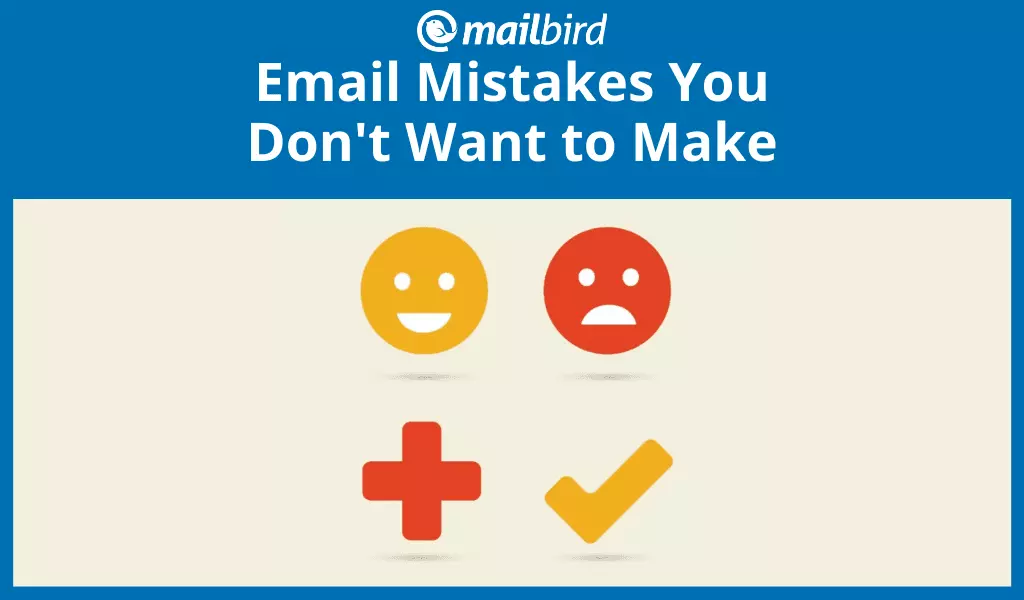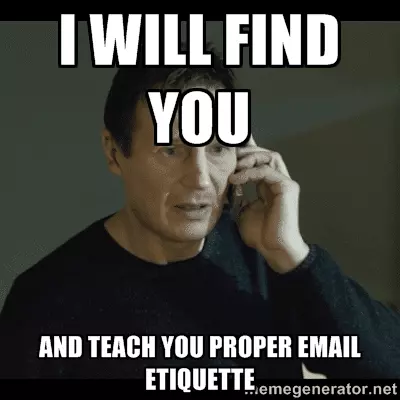30 Email Mistakes You Don’t Want to Make Ever

While dealing with a lot of information every day, it's not uncommon to make a few email mistakes along the way. However, if you're making these mistakes unknowingly, it's time to brush up on your email etiquette.
We've compiled a list of common email mistakes, which will come in handy when you're sending out an important message and want to make sure you haven't committed a serious snafu. Take a look, and bookmark this page (Ctrl + D) for future reference.
Common Email Mistakes to Avoid

#1. Rushing to reply
Replying to an email without having read all the messages in that thread can cause you to miss important points/answers you should be aware of before replying.
#2. Forwarding useless messages, chain emails, etc.
It's not the early 2000s; forwarding useless messages is a top email mistake that wastes other people's time and decreases your credibility. Make sure you think twice before forwarding such emails, and do it only if you think the other person would benefit.
#3. Rushing to hit "send"
Hitting the "send" button before you intend to can cause awkward situations, such as missing the subject line. Prevent this by adding the recipient's email address after you've finished drafting the email.
#4. Including your signature in every email
Adding the same long signature every time you send emails becomes annoying in a threaded email. A good solution is to add your signature in the first email and then use only your first name or initials in future replies.
#5. Mistakenly replying to all
This is one of the top five common email mistakes to avoid, generally occurring when you reply in haste. It's always a good idea to take your time when replying to an important email.
#6. Forgetting to add the attachment
Most email clients alert you when you're about to send an email in which you mention a word like "attachment" or "attach" but haven't actually attached a file. Still, you can avoid this problem by attaching the file as soon as you mention it in the email.
#7. Adding the wrong attachment
This happens purely by chance or when you're in a rush. Take your time to be sure to select the right attachment, or it might turn out to be a blunder.
#8. Adding the wrong address by selecting the first one from the suggested drop down
When typing someone's email address, you may tend to select the first one from the suggested drop-down list. It's always a healthy practice to check the recipients' email addresses carefully before hitting the "send" button.
#9. BCCing the wrong person
One of the top mistakes can be mixing up recipients between the CC and BCC fields, which can be disastrous. It's always best to enter the recipients' emails carefully once you've finished writing the message.
#10. Not including a basic greeting
Sending your first email in a conversation without a basic email greeting seems rude. A greeting can be formal or informal, but it sets the proper tone.
#11. Emailing when you're angry or drunk
Don't do it; enough said.
#12. Writing with your Caps Lock on
Writing in caps is sometimes used to emphasize certain words, but writing an entire message in caps is considered yelling in many cultures, so avoid doing it. Instead, you can bold the part you want to emphasize.
#13. Being too formal
Being somewhat formal is required in some business communications, but taking it too far will only get in the way of building good relationships.
#14. Being too informal too soon
Special care should be taken when initiating a conversation with a business contact or someone you don't know. Being too informal can make a bad impression on the recipient and undermine your credibility.
#15. Sending a canned response without changing the dynamic fields
The greater the number of dynamic fields in a canned message, the more careful you should be while sending out the email. Double-check it, always.
#16. Spelling mistakes
Most email clients have an integrated spell checker, but a spell checker doesn't catch all mistakes. There is nothing more annoying than seeing spelling or grammatical mistakes in an email.
#17. Waxing poetic
Writing an unnecessarily long email simply wastes time for you and the recipient. Don't write a great American novel; keep it short and relevant.
#18. Forgetting to account for the email tone
Email doesn't have non-verbal cues like facial expressions, body language, etc., so it becomes even more important to watch your tone while writing an email.
#19. Breaking up by email
That's plain rude. The other person deserves better.
#20. Too many emoticons
When using email for business communication, make sure not to use too many emoticons, which makes you look unprofessional.
#21. Using a generic term like "To whom it may concern"
Your email can easily be discarded if you are sending emails with generic terms like this. Even if you don't know the name of the person to whom you're reaching out, you can always use the designation of the person in the organization, like Marketing Manager, Hiring Manager, etc.
#22. Having too much information in your email signature
That's a sign of poor email etiquette. Make sure you're not making these terrible email signature mistakes.
#23. Sending an email without rereading it
Double-checking before sending ensures you are not making simple spelling mistakes like "sneak peak" and mixing up "there" with "their."
#24. Spending too much time managing emails
Managing email is not your full-time job. The McKinsey Global Institute found that an average office worker spends over a quarter of the day dealing with emails. To be more efficient, read about how to be more productive with your inbox.
#25. Not knowing when to use To or CC
There are no hard and fast rules for how to use the To and CC fields, but a generally accepted guideline is that when you add someone to the To field, it means you are expecting their reply, and CC is meant to keep people in loop.
#26. Not implementing the NNTR policy
NNTR stands for No Need To Reply. Sometimes, you need to reply, being polite when there is no need for an additional message. When you know the conversation is going to end, you should add a message like "No response is necessary."
#27. Using a vague subject line
Subject lines are of critical importance because that's your first chance to get the desired attention. Make your subject line concise yet relevant. Adding elements like [Urgent], [Rights Reserved], etc. can alert the recipient if the email requires an immediate response.
Using a creative subject line is another way of grabbing the recipient's attention, but you have to be careful; otherwise, your email can be marked as spam automatically.
#28. Failing to use the in-line reply feature
Another common email mistake is grouping replies together for an email that has questions in bullet points, which makes the recipient scroll up and down to read the question and then your answer. In-line replies serve as a good practice here, making it easier to read replies relative to the question.
#29. Sending sensitive information without proper caution
Thinking no one will ever see your email apart from the intended recipient is foolish. Once an email is sent, consider it public because you have no control over who may see it.
#30. Not providing an alternative contact in your vacation auto-responder
Not specifying an alternate contact in case someone needs to contact you or your office during an emergency is one of the most common mistakes. The alternate contact can come in handy while you're away and have your vacation auto-responder turned on.
Did we miss anything? Let us know in the comments.
FAQ
What are some common email mistakes?
1. Not using a greeting or closing 2. Being too formal or informal 3. Not adding the subject or adding a bad subject 4. Sending your message to everyone on your email list 5. Making spelling or grammatical errors
How do you write an email without grammar mistakes?
The sender must always be careful with his or her grammar when sending a professional email. As such, the sender must be up-to-date with the basics of grammar. Eliminating distractions while writing a correspondence, as well as proofreading, can help you avoid grammatical mistakes.
How do you apologize for email mistakes?
If you wrongly send an email, here are some tips on how to apologize: 1. Be sincere with your apology. 2. Own up to your mistake. 3. Explain how the mistake happened. 4. Present your next steps of action. 5. Ask for forgiveness.
What happens if you send an email to the wrong email address?
If you accidentally sent an email to an invalid address, you may get a bounce informing you that it wasn't delivered. However, you may have sent it to a valid address, in which case the receiver may open and read your accidental email.